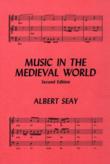Pérotin
Period: Medieval
Born: c. 1160
Died: c. 1205
Nation of Origin: France
Major Works:
Perotin is one of the earliest known composer of polyphonic organum. His works and the works of his contemporary, Leonin, are classified as Notre Dame Organum.
Sederunt principes, his famous 4-voice organum
He also revised Leonin's Magnus liber organi de graduali et antiphonario pro servitio divino multiplicando (The Great Book of Organum), 2-voice organum settings for services throughout the church year
Other Information:
Little is known about the life of Perotin. His birth date is probably between 1155 and 1160 but his death date is unknown and can only be estimated. He worked in a church called "Beatae Mariae Virginis" and later worked as a choirmaster in the Notre Dame cathedral in Paris. He is one of the earliest known composers of polyphonic church music known as "organum". Organum involved a simple doubling of the chant at an interval of a fifth or fourth above or below. As organum evolved, the voices became increasingly independent creating polyphony as we know it today. Below is a short summary of polyphony in early European music.
The evolution of organum follows this scheme.
Parallel Organum at the Fourth or Fifth - 10th century
Oblique motion to Parallel Organum at the Fourth - 10th century
Use of Oblique, Contrary, and Parallel motion -11 century
Florid Organum - 12th century
In Florid Organum a highly ornamented second voice was set against long notes in the "tenor". After the advent of Florid Organum, the older style of note against note was referred to as "discant" organum.
12th - 13th c. measured organum involved the alternation of organal and discant sections.
In the organal section each note of the syllabic/neumatic section of the chant or cantus firmus was set against up to 40 notes in the second voice. In the discant section each note of the melismatic section of the cantus was set against one to three notes in the second voice.
Notre Dame Organum is most important in that rhythm was introduced according to a system of rhythmic modes. Leonin (late 12th c.) began to use the rhythmic modes in his 2-part works (organum duplum). Modal rhythm was even more prominent in the 3-part works (organum triplum) of Perotin. Polyphonic treatment was restricted to plainchants of the Graduals, Alleluias, Responsories, and the "Benedicamus Domino," but only the soloist sections were used for polyphonic treatment. Perotin's work went well beyond the work of his predecessor, Leonin, in that he used triadic structures and some rudimentary canonic elements.
General Bibliography:
Reese, Gustave, Music in the Middle Ages : With an Introduction on the Music of Ancient Times, W.W. Norton & Company, October 1940, ISBN: 0393097501
Sachs, Curt, The Rise of Music in the Ancient World, W. W. Norton & Company, 1943, ASIN: 0393097188
Seay, Albert, Music in the Medieval World, W. W. Norton & Company, 1943, ASIN: 0393097188
Slonimsky, Nicolas and Kuhn, Laura; Editors, Baker's Biographical Dictionary of Musicians, Gale Group, December 2000, ISBN: 0028655257
Sadie, Stanley and Tyrrell, John; Editors, The New Grove Dictionary of Music and Musicians, Groves Dictionaries, Inc., January 2004, ISBN: 0195170679
Rutherford-Johnson, Tim, Kennedy, Michael, and Kennedy, Joyce The Oxford Dictionary of Music, Oxford University Press, 6th Edition, 2012, ISBN: 0199578109
Links to essays at other sites:
Please note: Each link will open in a new window.
Biographical essay from Wikipedia
